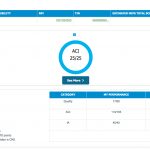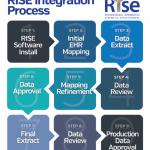
Tashatuvango/shutterstock.com
Quality assurance and quality improvement (QA/QI) work makes sense to focus on. However, finding the time and resources for QI projects is not always easy. Until now, the business case for QI in rheumatology practice has not always been clear.
However, this is changing with implementation of the Medicare Access and CHIP Reauthorization Act (MACRA) of 2015. MACRA brings an aggressive timeline for a Merit-Based Incentive Payment System (MIPS) and for Alternative Payment Models (APMs), such as accountable care organizations (ACOs).1
Under MIPS, a rheumatology practice will be graded according to a MIPS Composite Score that addresses quality, clinical practice improvement activities, advancing care information (this replaces meaningful use) and cost.2 Six quality measures, including an outcome or high-priority measure, must be demonstrated.
“For rheumatologists to be successful under these payment reforms, it will be critical to understand your current state with these quality measures and then implement quality improvement work that allows you to demonstrate improved performance in these specific areas,” explains Sonali Desai, MD, MPH, a rheumatologist and medical director of quality and ambulatory patient safety for the Department of Medicine at Brigham and Women’s Hospital in Boston.
Mastering the QI Process
 Although 2017 is considered a transition year for MIPS—meaning physicians can choose their level of participation—this is an important time to be establishing QI work, according to Dr. Desai.
Although 2017 is considered a transition year for MIPS—meaning physicians can choose their level of participation—this is an important time to be establishing QI work, according to Dr. Desai.
She says rheumatologists understand the importance of quality and have many ideas for QI; however, it is far more difficult to implement the work to improve quality within the busy routine of daily practice. “This requires a dedicated infrastructure and team to make happen, and the time, resources and financial support for this are not always readily available.”
She shares these key elements that must be in place for successful QI work:
- Mobilize commitment by building a QI team, with designated tasks for an agreed-upon goal. The team should include a leader who can ensure project buy-in from others.
- Support active listening among team members to agree on a quality measure to improve and to allow open dialogue for any expressed concerns about the project before it begins.
- Set a timeframe for project milestones.
- Establish a clear metric to improve and confirm the method for collecting the data, including what type of data to collect, how to collect it, what improvements to make and how to communicate the improvement data back to the team.
- Have a plan in place for regularly monitoring improvement practices to sustain the improvement.
“Effective quality improvement doesn’t have to be complicated; it can begin with a list of patients and a data point to track,” she adds. It can involve a simple Excel spreadsheet to track patients and a column for whether a metric is being met or not. For example, an improvement project her team took on several years ago focused on patients who were on immunosuppressive medications and who needed a pneumococcal vaccination.3 A mail merge was used to identify patients who were coming in for their routine rheumatology visits, and a printed order sheet for pneumococcal vaccination was added to these patients’ files and stapled to the paper billing sheet.
“By just focusing on pneumococcal vaccination, this work helped prime our team to think about all vaccines within the context of the improvement workflow we established,” Dr. Desai notes. “In addition, when the CDC guidelines for pneumococcal vaccination were changed a few years ago, our rheumatology practices were able to more easily adapt these recommendations into clinical practice.”
She does caution that considerations for how to implement a QI project do differ between a small private practice and a medical group in a large academic setting. However, she says one common denominator for finding success with QI is establishing “quick wins” with mini quality projects.
Here are five mini quality projects that Dr. Desai suggests can help jumpstart the QI process for a rheumatology practice:
- Track uric acid levels for patients with gout.
Project goal: Improve early identification of patients with gout, and monitor to reduce incidence of gout attacks.
Data to measure: Identify and follow all patients with gout through billing codes, medication lists and uric acid lab tests. - Measure bone density and osteoporosis treatment in women older than age 65 who are seen in rheumatology practices.
Project goal: Identify female patients who are at high risk for osteoporosis to reduce their risk of fracture.
Data to measure: Track the incidence of bone-density tests and use of appropriate osteoporosis medications, incidence of osteoporotic fractures and associated risk factors, such as long-term steroid use and patients with rheumatoid arthritis. - Measure immunosuppressed patient vaccination rates.
Project goal: Improve the rate of up-to-date vaccinations for all patients prescribed immunosuppressive rheumatology medications.
Data to measure: Patient vaccination history, discussion with clinician regarding education related to the need for vaccinations and immuonosuppressive medications. - Monitor regular lab testing for patients on specific medications.
Project goal: Improve standardized monitoring of lab testing for patients on such medications as immunosuppressants.
Data to measure: Patients according to immunosuppressant medications and associated regular blood tests for these patients. Caveat: Different lab testing is required for different medications. - Monitor a checklist of interventions for patients on immunosuppressants.
Project goal: Improve standardized confirmation and completion of specific checklist items required for patients on immunosuppressants, including regular lab testing (baseline and hepatitis related), tuberculosis screening/testing, discussion of the risks and benefits of medication and vaccinations.
Data to measure: Patients prescribed immunosuppressants with cross-reference for patient status with up-to-date vaccinations, labs and documentation of risk/benefit discussion.
Managing Quality Data
An additional challenge to receiving credit for QI under MIPS is being able to report demonstrated improvement data. One tool rheumatologists are using to meet MIPS data requirement is the ACR’s RISE (Rheumatology Informatics System for Effectiveness) Registry, according to Salahuddin Kazi, MD, vice chair of education and director of residency training in the Department of Internal Medicine’s Division of Rheumatic Diseases at the University of Texas Southwestern Medical Center in Dallas.
RISE works through a software plug-in that maps to a practice’s electronic health record (EHR) system to collect patient care data (stripped of patient identifiers) after entry and allows the practice to analyze and track the data according to 20 quality measures. Currently, 327 practices and 797 healthcare professionals are actively submitting data to the RISE registry on more than 1 million patients and more than 5 million encounters. These are mostly from smaller private practices, but several large academic institutions are also connected to RISE or are working to connect to the registry, according to Dr. Kazi.
‘Effective quality improvement doesn’t have to be complicated; it can begin with a list of patients & a data point to track.’ —Dr. Desai
He and colleagues working with the RISE Registry recently reported on quality improvement performance of RISE practices, which showed that for six of nine measures for which CMS has set national benchmarks, the average performance of RISE practices exceeded targets.4

Dr. Kazi
Dr. Kazi is happy to see this successful performance data, and he is equally excited about the valuable patient data in RISE that can be accessed for research to improve rheumatology care. For example, among 40 practices sharing data with RISE, these practices began with a 20% rate of tracking disease activity in patients with RA and these same practices now have a 60% rate of tracking this quality measure. Dr. Kazi sees this as a clear indicator of increased activity around quality improvement activities that can directly improve patient care.
“Whatever you will measure you will improve,” Dr. Kazi says.
To those practices still pulling together resources to get improvement work underway, and to those who may be struggling in these efforts, he suggests taking a closer look at underlying cultural issues around improvement.
“Being successful with improving and sustaining quality is about knowing your DNA—look at your resources, look at your people, and look at the ways you hold your team members accountable for performance,” he suggests. “You have to get people really engaged in improvement work to get to that next level of truly achieving sustained higher quality.”
Carina Stanton is a freelance science journalist based in Denver.
References
- Von Feldt JM. Helping rheumatologists RISE in the era of MACRA. The Rheumatologist. 2016 Aug;10(8):8.
- American College of Rheumatology. RISE is ready for MIPS. 2017 Feb 16.
- Desai, SP, Lu B, Szent-Gyorgyi LE, et al. Increasing pneumococcal vaccination for immunosuppressed patients: A cluster quality improvement trial. Arthritis Rheum. 2013 Jan;65(1):39–47.
- Yazdany J, Bansback N, Clowse MEB, et al. Practice-level variation in quality of care in the ACR’s Rheumatology Informatics System for Effectiveness (RISE) [abstract 2985]. Arthritis Rheumatol. 2016;68(suppl 10).


